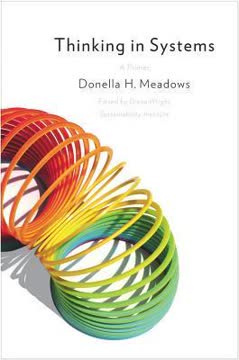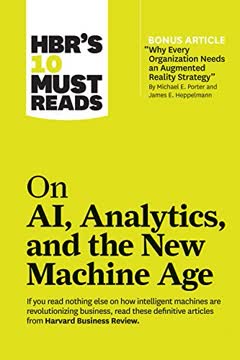Key Takeaways
1. AI and analytics are transforming business processes across industries
"AI powerfully magnifies the value created by those capabilities."
Process automation: AI and analytics are being used to automate digital and physical tasks, particularly back-office administrative and financial activities. This includes transferring data between systems, updating customer files, reconciling billing systems, and extracting information from documents using natural language processing.
Data-driven insights: Machine learning algorithms are being applied to detect patterns in vast volumes of data and interpret their meaning. This enables businesses to:
- Predict customer behavior and preferences
- Identify fraud in real-time
- Analyze product data for safety or quality issues
- Automate targeting of digital ads
- Provide more accurate actuarial modeling for insurance
Enhanced engagement: Natural language processing chatbots and intelligent agents are being used to engage employees and customers. This allows companies to provide 24/7 customer service, answer employee questions on IT and HR topics, and offer personalized product recommendations.
2. Augmented reality is becoming a powerful tool for visualization and training
"AR will become the new interface between humans and machines, bridging the digital and physical worlds."
Visualizing data: AR allows users to superimpose digital information directly on real objects or environments. This enables:
- Revealing internal features of objects (e.g. AccuVein showing veins under the skin)
- Demonstrating product capabilities (e.g. Bosch showing internal components of machinery)
- Overlaying data on physical environments (e.g. construction plans overlaid on building sites)
Guided instruction: AR provides real-time, on-site, step-by-step visual guidance for tasks such as:
- Assembly of complex products
- Operation of machinery
- Warehouse picking and logistics
Remote collaboration: AR enables remote experts to see what an on-site user is viewing and provide immediate guidance. This improves worker performance and reduces costs for activities like field repairs and maintenance.
3. Drones are revolutionizing data collection and aerial operations
"Drones are starting to fill the 'missing middle' between satellites and street level, digitizing the planet in high resolution and near–real time at a tiny fraction of the cost of alternatives."
Data collection: Drones equipped with cameras and sensors can gather high-resolution data from above, enabling:
- Mapping and surveying of construction sites, farms, and infrastructure
- Inspection of buildings, bridges, power lines, and other structures
- Monitoring of crops, wildlife, and environmental conditions
Operational applications: Beyond data collection, drones are being used for:
- Delivery of goods in remote areas
- Search and rescue operations
- Spraying of crops and distribution of seeds
- Providing temporary communications networks
Industry impact: Drones are transforming operations across industries:
- Construction: daily site mapping and progress monitoring
- Agriculture: precision farming and crop management
- Energy: inspection of wind turbines and solar panels
- Insurance: assessment of property damage
- Film and media: aerial cinematography
4. Blockchain technology promises to revolutionize transactions and record-keeping
"With blockchain, we can imagine a world in which contracts are embedded in digital code and stored in transparent, shared databases, where they are protected from deletion, tampering, and revision."
Decentralized ledger: Blockchain creates a distributed database where:
- Each party has access to the entire database and its history
- Communication occurs directly between peers without intermediaries
- Every transaction is transparent yet pseudonymous
- Records are irreversible and tamper-proof
Smart contracts: Blockchain enables the creation of self-executing contracts with the terms directly written into code. This can automate and enforce the negotiation or performance of an agreement.
Potential applications: While still emerging, blockchain could transform:
- Financial services: faster, cheaper transactions and settlements
- Supply chain management: improved traceability and transparency
- Healthcare: secure sharing of medical records
- Government: tamper-proof voting systems and public records
- Digital identity: user-controlled identity verification
5. 3D printing is enabling mass customization and reshaping manufacturing
"Additive is fulfilling its promise. It is now competitive with conventional manufacturing in its ability to make tens and even hundreds of thousands of units a year."
Mass customization: 3D printing allows for cost-effective production of customized goods, including:
- Medical devices like hearing aids and prosthetics
- Dental products like aligners and crowns
- Personalized consumer goods like eyewear and jewelry
Complex geometries: Additive manufacturing enables the creation of intricate designs that are impossible or prohibitively expensive with traditional methods. This is particularly valuable for:
- Aerospace components with optimized shapes for weight reduction
- Medical implants with porous structures that promote bone growth
- High-performance parts with internal cooling channels
Supply chain transformation: 3D printing is changing how products are made and distributed:
- On-demand production reducing inventory and waste
- Localized manufacturing closer to end customers
- Digital inventories of design files instead of physical parts
6. Human-AI collaboration is key to unlocking the full potential of AI
"Through such collaborative intelligence, humans and AI actively enhance each other's complementary strengths: the leadership, teamwork, creativity, and social skills of the former, and the speed, scalability, and quantitative capabilities of the latter."
Complementary strengths: Effective human-AI collaboration leverages:
- Human strengths: creativity, empathy, contextual understanding, ethical judgment
- AI strengths: processing vast amounts of data, identifying patterns, consistent performance on repetitive tasks
Key roles for humans:
- Training: Teaching AI systems and refining their performance
- Explaining: Interpreting AI outputs, especially for complex or sensitive decisions
- Sustaining: Ensuring responsible and ethical use of AI systems
Augmenting human capabilities: AI can enhance human work by:
- Providing relevant information and insights at the right time
- Automating routine tasks to free up time for higher-value work
- Enabling more personalized customer interactions at scale
7. Digital platforms are creating new "hub economies" dominated by tech giants
"Hub firms don't compete in a traditional fashion—vying with existing products or services, perhaps with improved features or lower cost. Rather, they take the network-based assets that have already reached scale in one setting and then use them to enter another industry and 're-architect' its competitive structure—transforming it from product-driven to network-driven."
Network effects: Digital platforms benefit from increasing returns to scale:
- More users attract more complementary products/services
- More data improves AI algorithms and personalization
- Greater scale increases bargaining power with partners
Industry transformation: Hub firms are reshaping traditional industries:
- Retail: Amazon and Alibaba dominating e-commerce
- Media: Facebook and Google capturing digital advertising
- Transportation: Uber and DiDi disrupting taxi services
- Finance: Ant Financial and PayPal challenging traditional banks
Concentration of power: This trend raises concerns about:
- Market dominance and reduced competition
- Data privacy and control
- Wealth inequality as value accrues to a few companies
- Dependence of other businesses on powerful platforms
Last updated:
FAQ
What's "HBR's 10 Must Reads on AI, Analytics, and the New Machine Age" about?
- Collection of Articles: The book is a compilation of ten articles from Harvard Business Review, focusing on the impact of AI, analytics, and machine learning on business and management.
- Topics Covered: It explores various topics, including AI's role in business processes, the integration of augmented reality, the potential of blockchain, and the rise of drones in industry.
- Expert Insights: The articles are written by leading experts and provide insights into how these technologies are transforming industries and creating new opportunities for businesses.
Why should I read "HBR's 10 Must Reads on AI, Analytics, and the New Machine Age"?
- Comprehensive Overview: The book offers a comprehensive overview of how AI and related technologies are reshaping the business landscape.
- Practical Advice: It provides practical advice and strategies for managers and leaders to leverage these technologies effectively.
- Future Trends: Reading this book will help you understand future trends and prepare your organization for upcoming technological changes.
What are the key takeaways of "HBR's 10 Must Reads on AI, Analytics, and the New Machine Age"?
- AI Integration: AI is most effective when it complements human capabilities rather than replacing them, leading to collaborative intelligence.
- Augmented Reality: AR is transforming how businesses operate by enhancing visualization, instruction, and interaction with products.
- Blockchain Potential: Blockchain has the potential to revolutionize transactions and contracts, though widespread adoption will take time.
How does "HBR's 10 Must Reads on AI, Analytics, and the New Machine Age" define collaborative intelligence?
- Human-Machine Collaboration: Collaborative intelligence involves humans and AI working together, enhancing each other's strengths.
- Roles for Humans: Humans are needed to train AI, explain its outputs, and ensure its responsible use.
- AI's Role: AI can amplify human cognitive abilities, interact with customers, and embody human skills to extend physical capabilities.
What insights does "HBR's 10 Must Reads on AI, Analytics, and the New Machine Age" provide on augmented reality?
- Bridging Digital and Physical: AR bridges the gap between digital data and the physical world, enhancing decision-making and productivity.
- Applications in Business: It is used in product development, manufacturing, logistics, and customer service to improve efficiency and reduce errors.
- Future Potential: AR is expected to become a key interface in various industries, transforming how businesses interact with their environments.
How does "HBR's 10 Must Reads on AI, Analytics, and the New Machine Age" address the use of drones in business?
- Data Collection: Drones are valuable for collecting high-resolution data quickly and cost-effectively, transforming industries like construction and agriculture.
- Autonomous Operations: The book discusses the potential for drones to operate autonomously, further reducing costs and increasing efficiency.
- Business Applications: Drones are used for mapping, inspection, and monitoring, providing new insights and capabilities for businesses.
What does "HBR's 10 Must Reads on AI, Analytics, and the New Machine Age" say about blockchain's impact on business?
- Distributed Ledger Technology: Blockchain offers a secure, transparent way to record transactions, potentially transforming industries reliant on contracts and records.
- Adoption Challenges: While promising, blockchain's widespread adoption faces technological, regulatory, and social challenges.
- Future Applications: The book suggests that blockchain could eventually support complex applications like smart contracts and public identity systems.
How does "HBR's 10 Must Reads on AI, Analytics, and the New Machine Age" explore the concept of platform marketing?
- AI Assistants: The book discusses how AI assistants like Alexa and Google Assistant are changing consumer behavior and marketing strategies.
- Consumer Trust: AI platforms are becoming trusted advisors, influencing purchase decisions and ensuring seamless consumer experiences.
- Strategic Shifts: Companies need to focus on influencing AI platforms to gain preferential positioning and access to consumers.
What strategies does "HBR's 10 Must Reads on AI, Analytics, and the New Machine Age" suggest for integrating AI into business processes?
- Incremental Approach: Companies should start with small, manageable AI projects to build capabilities and confidence.
- Cross-Functional Teams: Establishing dedicated teams for AI integration can help manage projects and develop necessary skills.
- Focus on Collaboration: Emphasizing human-AI collaboration can lead to significant performance improvements and innovation.
What are the best quotes from "HBR's 10 Must Reads on AI, Analytics, and the New Machine Age" and what do they mean?
- "AI will radically alter how work gets done and who does it." This highlights the transformative impact of AI on the workforce and business operations.
- "AR will become the new interface between humans and machines." This emphasizes the potential of augmented reality to change how we interact with technology.
- "Blockchain promises to solve this problem." Referring to inefficiencies in current systems, this quote underscores blockchain's potential to revolutionize transactions and contracts.
How does "HBR's 10 Must Reads on AI, Analytics, and the New Machine Age" address the ethical considerations of AI?
- Responsible Use: The book stresses the importance of ensuring AI systems are used ethically and responsibly.
- Bias and Fairness: It highlights the need to address potential biases in AI systems to prevent discrimination and ensure fairness.
- Regulatory Compliance: Companies must navigate complex regulations, such as the GDPR, to protect consumer data and privacy.
What future trends in AI and technology does "HBR's 10 Must Reads on AI, Analytics, and the New Machine Age" predict?
- Increased Automation: The book predicts a rise in automation across industries, with AI taking on more complex tasks.
- Expansion of AR and VR: Augmented and virtual reality will become more integrated into business processes and consumer experiences.
- Blockchain Adoption: While slow, blockchain adoption will continue to grow, eventually supporting transformative applications like smart contracts.
Review Summary
HBR's 10 Must Reads on AI, Analytics, and the New Machine Age receives mixed reviews. Many readers find it informative and thought-provoking, offering insights into emerging technologies and their impact on business. The book is praised for its diverse topics, including AI, blockchain, and 3D printing. However, some criticize it for being outdated due to the rapid pace of technological advancements. Readers appreciate the accessible writing style and practical implications discussed. While some articles are considered repetitive or shallow, others are highlighted as particularly enlightening, especially regarding the ethical implications of AI and its societal impact.
Similar Books










Download PDF
Download EPUB
.epub digital book format is ideal for reading ebooks on phones, tablets, and e-readers.














